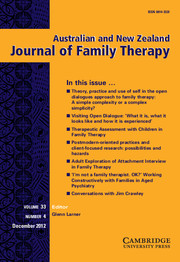Crossref Citations
This article has been cited by the following publications. This list is generated based on data provided by
Crossref.
2013.
Basic Family Therapy.
p.
172.
Al-khatib, Batul
and
Norris, Sarah
2015.
A Family Consultation Service: Single session intervention to build the mental health and wellbeing of children and their families.
Educational and Child Psychology,
Vol. 32,
Issue. 4,
p.
7.
Pitt, Tim
Thomas, Owen
Lindsay, Pete
Hanton, Sheldon
and
Bawden, Mark
2015.
Doing sport psychology briefly? A critical review of single session therapeutic approaches and their relevance to sport psychology.
International Review of Sport and Exercise Psychology,
Vol. 8,
Issue. 1,
p.
125.
Gee, Donna
Mildred, Helen
Brann, Peter
and
Taylor, Mandy
2015.
Brief Intervention: A Promising Framework for Child and Youth Mental Health?.
Administration and Policy in Mental Health and Mental Health Services Research,
Vol. 42,
Issue. 2,
p.
121.
Coates, Dominiek
2016.
Client and parent feedback on a Youth Mental Health Service: The importance of family inclusive practice and working with client preferences.
International Journal of Mental Health Nursing,
Vol. 25,
Issue. 6,
p.
526.
Furlong, Mark
2016.
Re-sizing Psychology in Public Policy and the Private Imagination.
p.
61.
Ewen, Victoria
Mushquash, Aislin R
Bailey, Kathleen
Haggarty, John M
Dama, Sumeet
and
Mushquash, Christopher J
2016.
Same-Day Counseling: Study Protocol for the Evaluation of a New Mental Health Service.
JMIR Research Protocols,
Vol. 5,
Issue. 1,
p.
e22.
Martyres, Kathya
and
Townshend, Phil
2016.
Addressing the Needs of Problem Gamblers With Co-Morbid Issues: Policy and Service Delivery Approaches.
Journal of Gambling Issues,
p.
68.
Binfet, John-Tyler
2017.
The Effects of Group-Administered Canine Therapy on University Students’ Wellbeing: A Randomized Controlled Trial.
Anthrozoös,
Vol. 30,
Issue. 3,
p.
397.
Coates, Dominiek
and
Howe, Deborah
2017.
Improving throughput in a youth mental health service.
International Journal of Health Care Quality Assurance,
Vol. 30,
Issue. 3,
p.
224.
Söderquist, Martin
Cronholm-Nouicer, Malena
Dannerup, Lars
and
Wulff, Karin
2018.
Ett Samtal i Taget: Parterapi på en gång.
Fokus på familien,
Vol. 46,
Issue. 4,
p.
261.
Furman, Lisa
and
Boeve, Hope
2018.
Itinerant art therapy: An educational model for community outreach therapeutic service.
The Arts in Psychotherapy,
Vol. 57,
Issue. ,
p.
65.
Young, Jeff
and
Dryden, Windy
2019.
Single-session therapy – past and future: an interview.
British Journal of Guidance & Counselling,
Vol. 47,
Issue. 5,
p.
645.
Fullen, Chrystal T.
2019.
The Therapeutic Alliance in a Single Session: A Conversation Analysis.
Journal of Systemic Therapies,
Vol. 38,
Issue. 4,
p.
45.
Le Gros, Jillian
Wyder, Marianne
and
Brunelli, Vanessa
2019.
Single session work: Implementing brief intervention as routine practice in an acute care mental health assessment service..
Australasian Psychiatry,
Vol. 27,
Issue. 1,
p.
21.
Young, Jeff
2020.
Putting Single Session Thinking to Work: Conceptual, Practical, Training, and Implementation Ideas.
Australian and New Zealand Journal of Family Therapy,
Vol. 41,
Issue. 3,
p.
231.
Biondo, Jacelyn
and
Gerber, Nancy
2020.
Single-Session Dance/Movement Therapy for People with Acute Schizophrenia: Development of a Treatment Protocol.
American Journal of Dance Therapy,
Vol. 42,
Issue. 2,
p.
277.
Courtnage, Alesya
2020.
Hoping for Change: The Role of Hope in Single-Session Therapy.
Journal of Systemic Therapies,
Vol. 39,
Issue. 1,
p.
49.
Kachor, Maureen
and
Brothwell, Joanne
2020.
Improving Youth Mental Health Services Access Using a Single-Session Therapy Approach.
Journal of Systemic Therapies,
Vol. 39,
Issue. 3,
p.
46.
Hoyt, Michael F.
and
Cannistrà, Flavio
2021.
Common Errors in Single-Session Therapy.
Journal of Systemic Therapies,
Vol. 40,
Issue. 3,
p.
29.


